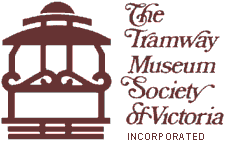
| About TMSV | Visitor information | Our collections |
Current projects | Feature articles | Join TMSV | Useful links | TMSV news |
 |
|||||||||
|
|||||||||
|
Collections
|
M&MTB PCC No 980
In 1938 the M&MTB obtained the Australian licence to import PCC patented technology and proposed to import a complete PCC double-ended tramcar from the USA for evaluation in Melbourne. These type of tramcars were the result of an initiative by the Electric Railway President’s Conference Committee to design and build a mass produced tramcar which would be competitive in service with contemporary automobiles. The resultant technology was state of the art in tramcar technology from the mid-1930s to the early 1960s. PCC-type tramcars were widely used in USA and Europe, some still being in revenue-earning service. Unfortunately the M&MTB’s proposal to import a PCC tramcar did not eventuate, being replaced in 1949 with the importation of a set of PCC trucks and control equipment. A modified SW6 type body was built for this equipment in 1950, but it differed in appearance from a standard SW6 type tramcar, as it was used to test out new features, such as an inclined windscreen and modified destination blinds arrangements. It is rumored that this tramcar whilst on test before entering service reached a maximum speed of 70 miles per hour (113 km/h) down St Kilda Road early one morning. Certainly US built PCC tramcars were capable of reaching this magnitude of speed. The high acceleration notch on the controllers was blocked from use, due to its significantly higher performance capability to standard W type tramcars. In addition, its braking performance was markedly superior to standard W tramcars, so initially it was used on the cross suburban route 69 in order to minimise the risk of accidents. However, in 1960 No 980 was transferred to the Bourke Street routes.
This tramcar was to be the prototype for the tramcars built for the conversion of Bourke Street bus routes to electric tram routes, but this did not eventuate due to lack of finance and foreign currency exchange restrictions that were in place at the time. No 980 was withdrawn from service in May 1971 and stored at Preston Workshops. It was subsequently used to test features for the prototype car No 1041 during 1972, including an interior heating system. Subsequently, the trucks, bolsters and control equipment were removed from No 980 and installed in No 1041. No 980 was then placed on unpowered No 1 trucks and used as a paint store in Preston Workshops until 1982, when it was donated to the TMSV and transported to Bylands. During 1999, the TMSV entered into an agreement with the Sydney Tramway Museum to swap X1 No 461 for PCC bogies and control equipment for No 980. This resulted in the acquisition of European copies of St Louis B3 PCC trucks from Brussels, but control equipment is still required for complete restoration. It is planned to restore 980 to full operational condition upon acquisition of the remaining control equipment.
|
![]() Last
updated 3
May 2002.
Last
updated 3
May 2002.
![]() Content
copyright © Russell
Jones 2001-3. Reproduced with permission.
Content
copyright © Russell
Jones 2001-3. Reproduced with permission.